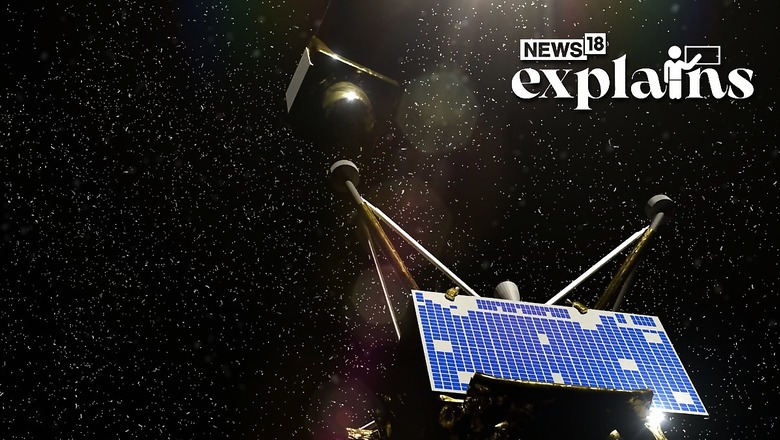
views
India’s Chandrayaan-3 launches today, and various agencies are working together to ensure a safe and successful mission. The Chandrayaan mission, also known as the Indian lunar exploration programme, involves a series of space missions conducted by ISRO.
The first mission, Chandrayaan-1, was launched in 2008 and successfully entered lunar orbit. Chandrayaan-2, launched in 2019, also entered lunar orbit successfully but encountered a setback when its lander deviated from its intended trajectory and crash-landed on the moon’s surface due to a software glitch.
Chandrayaan-3 comprises an indigenous lander module, a propulsion module, and a rover. Its objectives include the development and demonstration of new technologies required for interplanetary missions. The lander will have the capability to make a soft landing at a predetermined lunar site and deploy the rover, which will perform chemical analysis of the lunar surface during its mobility phase, as per reports.
As the launch date draws closer, let’s take a look at the previous Chandrayaan missions, and what to expect with its third installation:
About Chandrayaan-1
On October 22, 2008, India launched the Chandrayaan-1 spacecraft into Earth orbit using a PSLV rocket. After performing orbit-raising maneuvers, Chandrayaan-1 successfully entered orbit around the Moon on November 8 of the same year.
Over the next four days, it used its engines at specific intervals to achieve a circular orbit around 100 kilometers (62 miles) above the Moon’s surface. This allowed the spacecraft to closely study the Moon using its 11 instruments, with about half of them provided by NASA and European space agencies. Communication with the orbiter was lost on August 29, 2009, but the mission accomplished its main objectives, including the discovery of water on the Moon, according to a report by The Planetary Society.
The idea of launching Chandrayaan-1 originated from Dr. K. Kasturirangan, the former chair of ISRO. He envisioned ISRO’s involvement in India’s ambition to become a superpower, and the concept of a Moon orbiter received positive feedback. ISRO already had satellites designed for geostationary orbits, which could carry ample fuel. With some modifications, a geostationary satellite could be adapted for a lunar mission. Chandrayaan-1 became a natural progression of ISRO’s capabilities.
Discovering water on the Moon was a significant scientific goal of the Chandrayaan-1 mission. NASA contributed two instruments, the Miniature Synthetic Aperture Radar (Mini-SAR) and the Moon Mineralogical Mapper (M3), to aid in the search for water. Mini-SAR detected patterns consistent with water ice in the reflections from polar craters, while M3 analyzed how the lunar surface reflected and absorbed infrared light to confirm the presence of water. M3 also provided valuable data on the distribution of water and hydroxyl across the Moon. These findings were crucial for future lunar missions and understanding the Moon’s origin, the report explains.
About the Chandrayaan-2 Mission
Chandrayaan-2 is an Indian mission that aimed to send an orbiter, lander, and rover to the Moon. The spacecraft was launched in July 2019 as a combined unit. While the orbiter successfully entered lunar orbit, the lander with the rover onboard was unable to make a successful landing in the southern hemisphere of the Moon. The orbiter continues its mission to study the Moon from above.
This mission is a continuation of ISRO’s earlier Chandrayaan-1 orbiter, which was launched in October 2008 and operated for 10 months. Chandrayaan-2 incorporates improved instruments and new technologies intended for future planetary missions. The orbiter is designed to operate for seven years, while the lander and rover were expected to function for one lunar daytime if they had landed successfully, The Planetary Society explains in its report.
The objectives of the Chandrayaan-2 mission include enhancing our understanding of the Moon based on the data collected during the Chandrayaan-1 mission. The orbiter aims to map the Moon’s topography, study surface mineralogy and elemental abundances, investigate the lunar exosphere, and search for signs of hydroxyl and water ice.
The lander was named Vikram, in honor of Vikram Sarabhai, the founder of India’s space program. Its intended landing site was near the Moon’s south pole, at a latitude of approximately 70 degrees south.
About Chandrayaan-3
The Chandrayaan-3 spacecraft is the third lunar exploration mission planned by ISRO. It serves as a continuation of the Chandrayaan-2 mission and aims to showcase the complete capability of safe landing and roving on the lunar surface.
Chandrayaan-3 comprises a Lander and Rover configuration and will be launched by the LVM3 (Launch Vehicle Mark 3) from the Satish Dhawan Space Centre (SDSC) SHAR in Sriharikota. The propulsion module will transport the Lander and Rover configuration to a lunar orbit of approximately 100 km, as per a report by India.com.
The propulsion module is equipped with the Spectro-polarimetry of Habitable Planet Earth (SHAPE) payload, which is designed to conduct spectral and polarimetric measurements of Earth from the lunar orbit. This payload will provide valuable data and insights into the Earth’s characteristics and habitability from a unique vantage point on the Moon.
Chandrayaan-3 will consist of a rover and lander, without an orbiter like Chandrayaan-2. The mission aims to explore the Moon’s surface, particularly areas that have been deprived of sunlight for billions of years.
Scientists and astronomers suspect the presence of ice and valuable mineral resources in these dark regions. The exploration will not be limited to the surface but will also focus on studying the sub-surface and exosphere, as per reports. The rover will communicate with Earth using an orbiter borrowed from Chandrayaan-2. Surface analysis will be conducted by capturing images from a distance of 100 km above the lunar orbit.

















Comments
0 comment